Can mood meters truly measure employee engagement — and how to use them wisely as part of a broader people strategy?
Many organizations use mood meters to gauge employee sentiment, thinking they provide a quick pulse on workplace morale. However, we don’t think they work – here’s why:
1. Too Many External Influences: Employee moods fluctuate due to factors outside of work, such as adverse weather conditions, heavy traffic, and personal stress, which can skew the results. A grumpy response might be due to a rough morning commute (as experienced by those in large cities), rather than job dissatisfaction.
2. A Snapshot, Not a Trend: Mood meters capture the way an employee feels at the moment, not their overall experience at work. A happy click today doesn’t mean they’re engaged, just like a bad mood tomorrow doesn’t mean they’re disengaged.
3. Lack of Actionable Insights: A mood meter reading “unhappy” tells you nothing about why. Without context, how can leaders take meaningful action?
A highly engaged and motivated workforce is essential for long-term sustainability in today’s highly competitive business environment. In this context, organizations are continually seeking more accurate methods of measuring engagement. Mood Meters are one such tool that many modern organizations use. However, the question is, do Mood Meters measure employee engagement effectively?
Engaged employees are known to be highly productive and innovative, which helps drive organizational success and growth. However, keeping employees engaged is often challenging for most organizations.
While organizations invest considerable time and effort in developing the right policies to boost employee engagement, they often prove ineffective. Organizations overlook the importance of measuring employee engagement to get better results.
Measuring employee engagement is essential to understanding whetherthe existing policies are working or not. It also gives organizations valuable insights about the changes they must make to their people policies to boost engagement.

Gaining a deeper insight into how employees feel about their role, work environment, and even their managers can help organizations identify key engagement drivers.
It also makes it easier for companies to identify red flags that might reduce workforce engagement.
It provides them with ample time to take preventive or corrective measures to enhance HR policies that impact employee engagement. Organizations’ awareness of this fact has led them to adopt diverse tools and methodologies for measuring employee engagement.
Organizations use different methods to measure employee engagement, often in tandem to get better results.. A few standard methods are as follows:
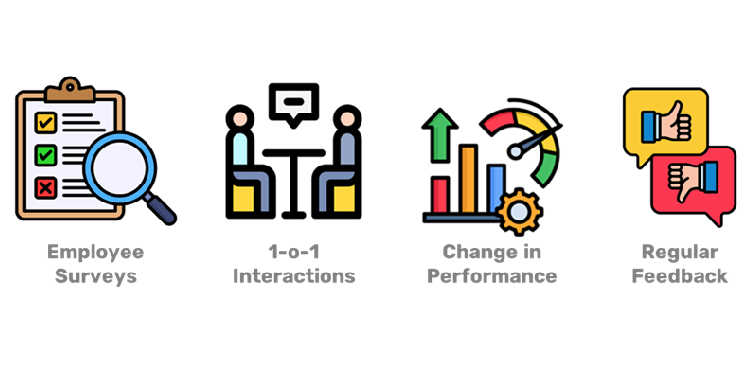
Organizations traditionally use surveys to understand employee engagement and satisfaction levels.
They provide vital information about what motivates employees to give their best in their current roles.
These surveys also provide valuable insights into how engaged and valued employees feel. These insights are crucial for developing effective policies that enhance employee engagement.
One-to-one interactions between employees and their managers facilitate open and fair communication. Such interactions are highly effective for building trust, making it easier for employees to share their concerns and discuss problems with their superiors.
This helps create a sense of community and engagement among the employees, boosting their engagement further.
Monitoring changes in performance metrics, such as productivity, goal achievement, and attendance, provides comprehensive insights into employee engagement levels. A positive increase in these metrics indicates enhanced engagement levels within the workforce.
Conversely, a decline in the performance metrics may indicate a reduction in employee satisfaction and engagement.
Seeking employee feedback is considered one of the most effective ways to measure engagement.
These sessions encourage employees to share their views and opinions about the various aspects that impact their performance and efficiency. They may even offer suggestions and feedback to support organizational and personal growth.
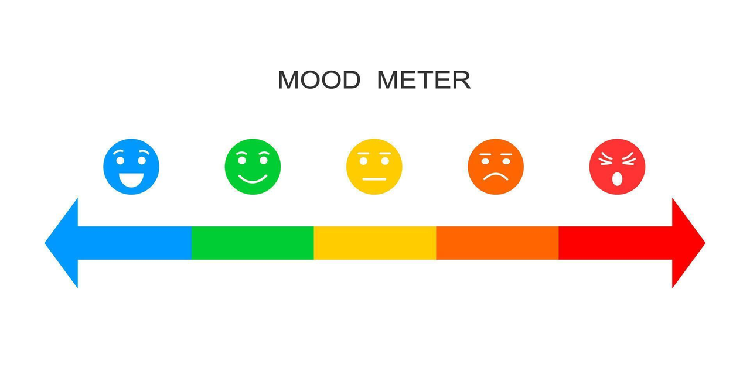
Organizations are constantly seeking new methods to measure engagement more accurately. Mood meters, also known as mood-o-meters, have emerged as one of the latest tools organizations use to measure employee engagement.
Mood Meters are tools or methodologies that help organizations understand and monitor their employees’ emotional states in real time.
The tool requires employees to answer questions about how they feel at various times during the workday or the week. The employees must choose from a given set of options: happy, excited, tired, anxious, angry, bored, and others.
Mood Meters provide an effective solution for organizations to learn about employees’ general frame of mind at any time. The accumulated information is presented in physical graphs, charts, or even digital dashboards. This makes it easier for business leaders to gauge the employee pulse and identify engagement trends.
They can use the information to take necessary actions to boost morale and engagement and create a positive work culture through increased emotional awareness.
In addition to helping organizations measure their employees’ engagement levels, mood metering offers the following additional benefits:
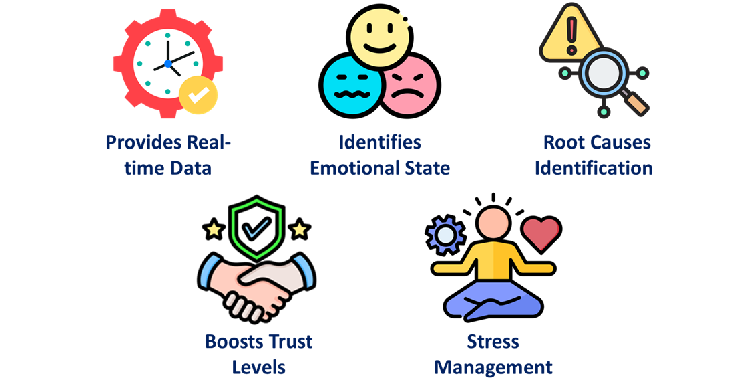
They provide real-time data about employees’ emotional states at different times and under diverse circumstances.
Randomly capturing employee sentiment enables organizations to assess their overall emotional well-being more accurately.
Most employees tend to suppress their emotions at work to stay focused on their tasks.
However, an organization’s use of a Mood Meter forces employees to acknowledge their feelings and even reflect on them.
Thus, they are empowered to address the various issues caused by their poor emotional state.
Mood Meters offer valuable insights to managers and supervisors about what motivates employees and makes them feel stressed.
The information is critical for efficient task delegation, preventing conflicts, and reducing workload imbalance.
This awareness of employee sentiment can help improve productivity, enhance communication, and foster trust and coordination within the workplace.
Employees who become habitual about sharing in the workplace help create a culture of openness.
They do not feel shy or fearful about expressing themselves in front of their peers or supervisors, which boosts employee confidence and reduces workplace stress and anxiety.
Mood Meters can help promote overall employee wellness and significantly reduce the chances of burnout.
By analysing the data collected, companies can learn about employees’ stress and frustration levels and take appropriate actions to reduce them. Thus, they can prevent employees from developing serious health issues due to a lack of awareness about their emotional state.
Mood Meters are gaining much popularity within organizations looking to improve their process for measuring engagement. The fact that many leading organizations worldwide are utilizing these tools has further promoted this trend.
A few well-known organizations that use the tool to assess employee mood include the following:

This technology giant is renowned for its excellent workplace culture, which is primarily data-driven. Hence, it is not surprising that the company uses various mood-tracking tools to assess the emotional state of its employees and make relevant changes to its workplace strategies.
Microsoft is another technology giant recognized for its significant investment in the well-being of its employees. The company utilizes mood meter tools to monitor the emotional well-being of its workforce and track engagement levels, thereby enhancing overall experiences.
Salesforce employees are required to participate in regular check-ins through various company apps. These apps integrate mood-tracking features with engagement metrics to better understand employee experiences and sentiments.
The organization has established internal platforms to gather random, real-time feedback on employees’ moods. It helps establish a positive workplace culture, strengthens trust between coworkers, and boosts their confidence and well-being.
Despite their obvious benefits, mood metering does not always accurately measure employee engagement in the workplace. Here are the limitations of this tool:
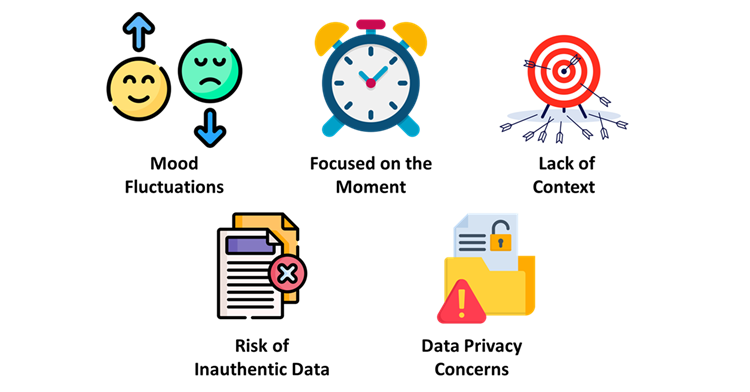
Individuals’ moods do not remain constant even under the same circumstances. They can fluctuate for the simplest reasons, and most mood meters can’t handle these fluctuations.
Hence, the data obtained through these tools might not be accurate for the employee experience in the workplace.
Mood Meters collect real-time data and focus too much on the moment. It prevents the tool from providing comprehensive details of employee feelings, which can impact the overall outcome.
If the employees are momentarily happy, it might not reflect their actual sentiment within the workplace.
Mood Meters may be unable to factor in the appropriate context and insights while collecting the data, so the information obtained may not be entirely accurate. For example, an employee may record his mood as being stressed on a particular day, not because he is unhappy at the workplace, but due to personal problems.
Since Mood Meters do not record this context, it does not reflect their workplace engagement.
Mood Meters’ inability to provide 100% correct information about employees’ moods increases the risk of inauthentic reports.
It can build a false sense of confidence within organizations about the high engagement level of the employees, which can have highly damaging consequences for the organization’s long-term growth and success.
It is common for employees to be dishonest about their true feelings during Mood Meter surveys.
In most such cases, employees are worried about the safety and privacy of their data or fearful of facing the repercussions of expressing their genuine emotions.
Either way, the information collected by the mood meter proves useless for the organization as it cannot help them gauge the actual engagement level of their workforce.
Organizations should consider using mood meters in tandem with traditional tools to measure employee engagement more accurately and reliably. Here are a few best practices:
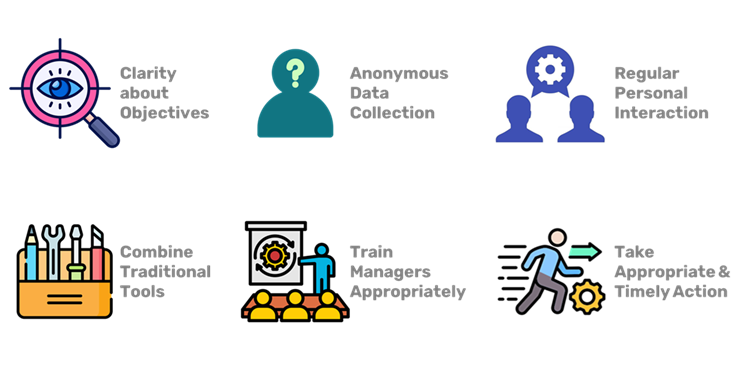
To get the best results, organizations should clearly understand what they want to achieve with Mood Meters. These objectives may range from assessing employee morale to gaining insights about their emotional well-being.
Clarity of purpose is essential for choosing the right emotions to focus on and the frequency at which the information is to be collected.
The best way to address privacy concerns while using the mood meter is to make the data collection anonymous.
It helps to get more authentic responses from the employees.
Regular 1-in-1 interactions with team members can help team leaders establish the authenticity of their responses.
They can also discuss the emotional aspects of the work with them to develop more effective engagement strategies.
Integrating mood Metering with conventional tools such as pulse surveys, regular feedback loops, and AI-based employee chatbots can greatly enhance efficiency and accuracy.
It helps cover comprehensive aspects that might impact workplace engagement, ensuring a 360-degree response for the employees’ emotional and physical experiences.
Managers and supervisors play a vital role in maximizing the accuracy and effectiveness of Mood Meter tools. Organizations should train their managers to respond correctly to employee emotions.
They should learn to empathize with employees’ emotional needs and encourage them to share their thoughts and feelings without fear.
The data collected through Mood Meters offers valuable insights into what employees need and expect.
Taking timely and relevant actions to fulfill these needs can go a long way in motivating employees to participate actively in such surveys.
Making employees feel valued and assuring them that the organization will address their needs can significantly boost their engagement.

It’s a digital tool that allows employees to record their current emotional state—such as “happy,” “tired,” or “anxious”—at various moments throughout the workday to gauge overall sentiment.
Not really. Mood meters capture only a moment in time, and moods can be influenced by external factors—such as traffic or weather—that don’t accurately reflect genuine workplace engagement.
1. External influences: Responses may reflect personal life or environment, not job-related feelings.
2. Momentary snapshots: They reveal how someone feels right at that moment, not their overall engagement.
3 Lack of context: Labels like “unhappy” don’t explain why an employee feels that way, limiting actionable follow-up.
There are several better approaches:
– Surveys (e.g., pulse or in-depth engagement surveys) to track sentiment trends over time.
– One-on-one interactions for qualitative understanding.
– Performance data analysis (e.g., productivity, attendance).
– Regular feedback loops are used to gather more profound insight into employee experiences.
Yes—if used carefully:
– Define clear objectives for what you aim to track.
– Ensure anonymity to get honest responses.
– Combine mood meters with traditional tools like surveys or feedback sessions.
– Train managers to respond empathetically and quickly to emotional signals.
Mood Meters can be vital tools for measuring employee engagement only when used correctly and combined with other available options. Organizations can benefit significantly by following the best practices of using mood meters and boost engagement by developing the right policies.

Lead author: Sagar Chaudhuri, the Co-Founder and CEO of HiFives. He is an HR Tech Evangelist with over 25 years of experience in both corporate and entrepreneurial settings. Previously, Sagar has held leadership roles with companies such as Genpact, Infosys, and ICICI Bank. He has an engineering degree from IIT Kharagpur and an MBA from IIM Lucknow. Connect on LinkedIn
To stay updated on the latest HiFives blogs, follow us on Twitter (@MyHiFives)